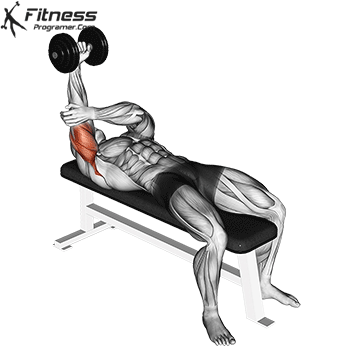Overview
The one-arm pronated dumbbell triceps extension is a unilateral exercise designed to isolate and strengthen the triceps while promoting muscular balance. The pronated grip (palm facing forward) shifts the workload slightly, placing additional tension on the lateral and long heads of the triceps.
How to Perform:

Step 1: Setup and Starting Position
- Lie flat on a bench with a dumbbell in one hand.
- Hold the dumbbell with a pronated grip (palm facing forward).
- Extend your arm straight up, positioning the dumbbell above your shoulder.
- Keep your elbow stationary, with your upper arm perpendicular to the floor.
Step 2: Execution
- Slowly lower the dumbbell by bending your elbow, bringing it toward the side of your head.
- Keep your elbow in place while your forearm moves.
- Lower the dumbbell until you feel a deep stretch in your triceps.
- Pause briefly, then extend your arm back to the starting position.
- Repeat for 8 to 12 reps, then switch arms. Complete 3 to 4 sets.
Tips for Proper Form
- Keep your elbow stable to ensure proper triceps activation.
- Use a controlled movement to avoid momentum and strain.
- Maintain a neutral wrist position to reduce stress on the joints.
- Engage your core to prevent excessive movement or arching.
- Breathe in while lowering the dumbbell and exhale as you extend.
Common Mistakes to Avoid
- Allowing the elbow to drift outward, reducing triceps isolation.
- Using excessive weight, which can lead to poor control and injury.
- Rushing through the movement, decreasing muscle engagement.
- Arching the lower back, which can cause discomfort or strain.
- Dropping the dumbbell too low, placing unnecessary stress on the shoulder.
Benefits:
Enhances Triceps Strength and Definition: This exercise effectively isolates the triceps, promoting muscle growth and endurance.
Improves Muscle Balance and Stability: By training one arm at a time, it helps correct muscular imbalances and strengthens stabilizing muscles.
Increases Arm Control and Coordination: The pronated grip variation places additional emphasis on grip and wrist stability, improving overall arm function.
Reduces Strain on the Shoulder and Wrist: The unilateral movement allows for a natural range of motion, reducing the risk of injury compared to barbell movements.
Supports Pressing Movements: Strengthening the triceps helps improve performance in bench presses, overhead presses, and dips.
Muscles Worked

